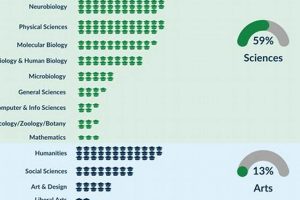Top-tier, spacious backpacks designed for academic settings are essential for carrying textbooks, laptops, and other supplies comfortably and efficiently. A quality pack can organize materials, distribute weight evenly, and protect electronics, facilitating a smoother school experience.
Ergonomic designs and ample storage capacity contribute to student well-being by reducing strain and promoting organization. Historically, student carryalls have evolved from simple satchels to specialized designs catering to modern educational needs, reflecting a growing understanding of the importance of comfortable and efficient load-bearing. The right pack can improve posture, lessen back pain, and contribute to a more positive overall academic experience.
This article will explore key features to consider when selecting a high-quality, roomy backpack suitable for academic use, including material durability, compartmentalization, comfort features, and appropriate sizing.
Tips for Selecting a Suitable Backpack
Choosing a suitable backpack is crucial for student comfort and academic success. Careful consideration of several key factors can ensure a productive and comfortable academic year.
Tip 1: Prioritize Durable Materials: Look for backpacks constructed from water-resistant, tear-resistant materials like nylon or polyester. Reinforced stitching and heavy-duty zippers are also indicators of long-term durability.
Tip 2: Consider Compartmentalization: Multiple compartments, including dedicated laptop sleeves and organizer pockets, allow for efficient organization of textbooks, notebooks, and electronic devices.
Tip 3: Evaluate Comfort Features: Padded shoulder straps, adjustable sternum straps, and a padded back panel can significantly improve comfort, particularly when carrying heavy loads.
Tip 4: Choose the Right Size: Backpack size should be proportional to the student’s body size and the volume of materials typically carried. Oversized backpacks can lead to strain and discomfort.
Tip 5: Check Weight Distribution: A well-designed backpack distributes weight evenly across the back, minimizing strain on the shoulders and spine. Look for features that promote balanced load carriage.
Tip 6: Assess Warranty and Return Policies: A reputable manufacturer’s warranty and a flexible return policy offer peace of mind and protect against potential defects.
Investing in a quality backpack that meets these criteria contributes to a student’s physical well-being and academic organization. A well-chosen pack facilitates efficient transport of educational materials and protects valuable electronics, contributing to a smoother, more productive academic experience.
By following these guidelines, individuals can select a backpack that effectively meets their academic needs and promotes long-term comfort and functionality.
1. Durability
Durability is a critical factor in determining the quality and longevity of backpacks designed for academic use. Heavy textbooks, electronic devices, and daily wear and tear place significant stress on these packs, making robust construction essential. A durable backpack protects its contents from damage and remains functional throughout the academic year, representing a worthwhile investment for students. For example, a backpack made from ripstop nylon with reinforced seams will withstand the rigors of daily use far better than one made from a less durable material.
The practical significance of durability extends beyond simply protecting belongings. A durable backpack reduces the frequency of replacement, offering long-term cost savings. Choosing a pack constructed from high-quality materials and featuring robust stitching and zippers can significantly extend its lifespan. This durability also contributes to peace of mind, allowing students to focus on their studies rather than worrying about equipment failure. Furthermore, a well-maintained, durable backpack can retain its value, potentially allowing for resale or repurposing.
In summary, prioritizing durability when selecting a backpack for school ensures reliable performance and longevity. Investing in a well-constructed pack minimizes the risk of damage to valuable belongings, reduces the expense of frequent replacements, and provides long-term utility. This focus on durability ultimately contributes to a more efficient and cost-effective academic experience.
2. Comfort
Comfort is paramount when selecting a large backpack for school. Carrying heavy textbooks, laptops, and other supplies for extended periods can strain the back and shoulders. A comfortable backpack minimizes this strain, promoting better posture and reducing the risk of pain or injury. Features such as padded shoulder straps, adjustable sternum straps, and a contoured, ventilated back panel distribute weight effectively and enhance breathability, contributing significantly to user comfort. For instance, a student carrying a heavy load with a backpack featuring ergonomic design elements will experience less physical stress compared to using a basic backpack lacking these features.
The practical significance of comfort extends beyond physical well-being. A comfortable backpack allows students to focus on their studies rather than discomfort. This enhanced focus can lead to improved academic performance and a more positive overall school experience. Furthermore, a comfortable backpack promotes proper posture, which can have long-term health benefits. By mitigating back pain and discomfort, students can maintain better physical health throughout their academic years. Proper weight distribution, achieved through adjustable straps and a supportive back panel, is crucial for comfort and injury prevention.
In summary, comfort is an essential factor in selecting the best large backpack for school. It directly impacts physical well-being, academic performance, and overall student experience. Prioritizing features like padded straps, adjustable fit, and ergonomic design ensures comfortable load carriage, contributing to a healthier and more productive academic life. Investing in a comfortable backpack is an investment in a student’s long-term health and academic success.
3. Capacity
Adequate capacity is a defining characteristic of backpacks designed for academic settings. Students often carry numerous textbooks, notebooks, laptops, and other supplies, necessitating a pack with sufficient storage space. A spacious interior and strategically designed compartments are essential for accommodating these items comfortably and efficiently. Insufficient capacity can lead to overpacking, disorganized materials, and potential damage to belongings. For example, a student carrying a 15-inch laptop requires a backpack with a dedicated, padded compartment of appropriate dimensions. A pack lacking this feature may not offer adequate protection or efficient organization. Ample capacity ensures that all essential materials are readily accessible and protected, contributing to a smoother, more organized academic experience.
The practical implications of capacity extend beyond simply holding belongings. A backpack with sufficient capacity allows for better weight distribution, reducing strain and promoting comfort. Compartments designed for specific items, such as laptops and water bottles, further enhance organization and prevent shifting during transport. This organization facilitates quick access to materials, minimizing time spent searching and maximizing efficiency. Moreover, adequate capacity allows students to carry all necessary items, reducing the need for multiple bags and streamlining their daily routine. For students involved in extracurricular activities, a spacious backpack can accommodate athletic gear or musical instruments, further enhancing its utility.
In conclusion, capacity plays a crucial role in defining the effectiveness of a backpack for school. Sufficient storage space, combined with intelligent compartmentalization, allows for efficient organization, protects belongings, and promotes comfort. A backpack with appropriate capacity directly contributes to a student’s organizational skills, physical well-being, and overall academic success. Selecting a pack with ample storage tailored to individual needs is a crucial step in preparing for a successful academic year.
4. Organization
Effective organization is a critical attribute of high-quality backpacks designed for academic use. The ability to arrange and access learning materials efficiently contributes significantly to student productivity and reduces stress. A well-organized backpack facilitates quicker retrieval of textbooks, notes, and supplies, minimizing time wasted searching and maximizing time spent on learning. Multiple compartments, dedicated pockets for electronic devices, and specialized organizers for pens and pencils contribute to a structured interior, allowing students to maintain order and easily locate necessary items. For example, a student with a dedicated laptop compartment, separate textbook sections, and a designated pouch for writing utensils can transition seamlessly between classes without rummaging through a disorganized bag. This organized approach fosters a more focused and efficient learning environment. Conversely, a poorly organized backpack can lead to misplaced assignments, forgotten materials, and increased anxiety, hindering academic performance.
The practical significance of organization within a backpack extends beyond simple convenience. A structured system for carrying academic materials promotes responsibility and time management skills. Students learn to categorize and prioritize their belongings, developing habits that contribute to overall academic success. Furthermore, an organized backpack minimizes the risk of damage to valuable items such as laptops or tablets. Dedicated, padded compartments protect electronics from impacts and scratches, ensuring their longevity and functionality. This protection safeguards students’ investments in technology and prevents disruptions to their learning process due to equipment damage. Moreover, a well-organized backpack can reduce physical strain. By distributing weight evenly and preventing items from shifting, it minimizes stress on the back and shoulders, contributing to better posture and overall comfort.
In summary, organization is a defining characteristic of superior backpacks for academic purposes. It fosters efficiency, reduces stress, and promotes responsibility. A well-organized backpack empowers students to manage their materials effectively, safeguarding their belongings and contributing to a more productive and positive learning experience. Investing in a backpack with thoughtful organizational features is an investment in academic success and overall well-being.
5. Style
While functionality remains paramount, style plays a significant role in backpack selection, particularly within the academic context. A backpack’s aesthetic can reflect personal expression, contribute to confidence, and even influence social dynamics. Balancing style with practicality is essential for maximizing the benefits of a large backpack for school. Understanding the nuances of style within this context allows for informed decisions that align with both practical needs and personal preferences.
- Aesthetics and Self-Expression
Aesthetics represent a crucial element of style. Color palettes, patterns, and overall design contribute to a backpack’s visual appeal and reflect individual preferences. A student might choose a vibrant, patterned backpack to express creativity or a sleek, minimalist design for a more understated look. The aesthetic appeal of a backpack can influence a student’s sense of self and contribute to their overall confidence in an academic setting. Selecting a backpack that aligns with personal aesthetics can enhance the overall school experience.
- Social Considerations
Backpacks often serve as social signifiers, particularly among student populations. Certain brands or styles may be associated with specific interests or social groups. While conformity is not always desirable, understanding the social implications of backpack choices can be beneficial. A student interested in a particular subculture might choose a backpack that reflects that affiliation, facilitating social connection and shared identity. Conversely, a student prioritizing individuality might opt for a unique or less mainstream style. Navigating these social considerations allows for informed choices that align with individual social goals.
- Trend vs. Timelessness
Style choices often involve navigating current trends versus timeless designs. Trendy backpacks might feature popular colors, patterns, or design elements that reflect current fashion. However, these trends can be fleeting, leading to a backpack feeling outdated quickly. Timeless designs, on the other hand, prioritize classic aesthetics and durable construction, offering longevity and enduring style. A student prioritizing long-term value might choose a classic, neutral-colored backpack that transcends trends. Considering the lifespan of a backpack in relation to current trends allows for a more informed and practical purchasing decision.
- Balancing Style with Practicality
While style is important, practicality should not be compromised. The most stylish backpack is ultimately ineffective if it lacks the necessary functionality for academic use. Durability, comfort, capacity, and organization remain paramount. A student must balance their desire for a stylish backpack with the need for a practical tool that effectively supports their academic endeavors. Choosing a backpack that successfully integrates both style and functionality ensures a positive and productive school experience. Prioritizing features like durable materials, ergonomic design, and ample storage while still considering aesthetics allows for a balanced and effective choice.
Ultimately, the style of a large backpack for school is a personal choice that should reflect individual preferences while complementing practical considerations. Finding a balance between aesthetics, social dynamics, and functionality ensures that the chosen backpack serves as both a practical tool and an expression of personal style, contributing to a positive and productive academic experience.
6. Value
Value, in the context of selecting the best large backpack for school, represents the relationship between cost and quality. It encompasses not only the initial purchase price but also the backpack’s durability, functionality, and overall contribution to the student experience. A high-value backpack may not be the cheapest option, but it offers a combination of features and durability that justifies its cost over time. For example, a backpack constructed from premium, water-resistant materials with reinforced stitching, ergonomic design, and ample storage may have a higher initial cost than a basic model. However, its longevity, comfort, and organizational capabilities contribute to a higher overall value proposition, potentially exceeding the initial price difference through extended use and enhanced academic performance.
Assessing value requires careful consideration of individual needs and priorities. A student prioritizing comfort might find greater value in a backpack with superior ergonomic features, even at a slightly higher price point. Conversely, a student primarily concerned with cost might prioritize a more basic, budget-friendly option, accepting potential trade-offs in durability or features. Evaluating value also involves considering long-term costs. A less expensive backpack that wears out quickly might necessitate frequent replacements, ultimately exceeding the cost of a more durable, higher-priced option over time. Furthermore, features like dedicated laptop compartments or water bottle pockets can add value by protecting expensive electronics and promoting hydration, contributing to overall well-being and academic success. For instance, a student regularly transporting a laptop would find significant value in a backpack with a dedicated, padded compartment, protecting their investment and minimizing the risk of damage.
Ultimately, understanding value in the context of large backpacks for school empowers informed purchasing decisions. It requires a holistic assessment of cost, features, durability, and the backpack’s overall contribution to academic life. Prioritizing value ensures that the chosen backpack meets individual needs and budgetary constraints while providing long-term utility and supporting a positive learning experience. Recognizing that the lowest price does not always equate to the best value allows for strategic investments that maximize both functionality and long-term cost-effectiveness.
Frequently Asked Questions
This section addresses common inquiries regarding the selection and utilization of large backpacks designed for academic settings. Clarity on these points facilitates informed decision-making and optimal backpack usage.
Question 1: How does one determine the appropriate backpack size for a student?
Backpack size should be proportional to the student’s torso length and the volume of materials typically carried. An oversized backpack can strain the back and shoulders, while an undersized one may not accommodate essential items. Measuring torso length and considering the student’s daily load helps determine the appropriate size.
Question 2: What materials offer the best durability and weather resistance?
Water-resistant, tear-resistant materials like ripstop nylon or ballistic polyester offer superior durability and protection against the elements. Reinforced stitching and heavy-duty zippers further enhance longevity.
Question 3: Are there specific features that promote back health and comfort?
Padded shoulder straps, adjustable sternum straps, a padded back panel, and a hip belt distribute weight evenly and minimize strain on the back and shoulders, promoting comfort and proper posture.
Question 4: How important is compartmentalization in a large backpack?
Compartmentalization is crucial for organization. Dedicated compartments for laptops, textbooks, and smaller items prevent shifting during transport, protect electronics, and facilitate easy access to materials. This organization promotes efficiency and reduces stress.
Question 5: What should one consider when selecting a backpack for a student with a laptop?
A dedicated, padded laptop compartment is essential for protecting the device from impacts and scratches. The compartment size should match the laptop’s dimensions, and it should be positioned to distribute weight evenly.
Question 6: How does one maintain and prolong the lifespan of a large backpack?
Regular cleaning, proper storage, and avoiding overloading contribute to a backpack’s longevity. Following manufacturer care instructions and promptly addressing any damage can significantly extend its lifespan.
Selecting a well-designed backpack contributes significantly to a student’s comfort, organization, and overall academic experience. Careful consideration of these frequently asked questions facilitates informed decisions that align with individual needs and priorities.
For further information on specific backpack models and recommendations, consult the subsequent sections.
Conclusion
Optimal backpack selection for academic settings requires careful consideration of various factors. Durability, comfort, capacity, organization, style, and value all contribute significantly to a backpack’s effectiveness and overall contribution to the student experience. Prioritizing these elements ensures that the chosen backpack not only meets immediate needs but also supports long-term academic success and well-being. A well-chosen backpack serves as a reliable tool, facilitating efficient organization, protecting valuable belongings, and promoting physical comfort, ultimately contributing to a more positive and productive learning environment.
Investing in a high-quality, spacious backpack represents an investment in a student’s academic journey. A thoughtfully selected pack empowers students to navigate their educational pursuits with greater ease and efficiency. By prioritizing the key features discussed, individuals can make informed decisions that align with their specific needs and contribute to a more successful and fulfilling academic experience. The right backpack becomes more than just a carrier of books and supplies; it becomes a supportive companion throughout the educational process.







